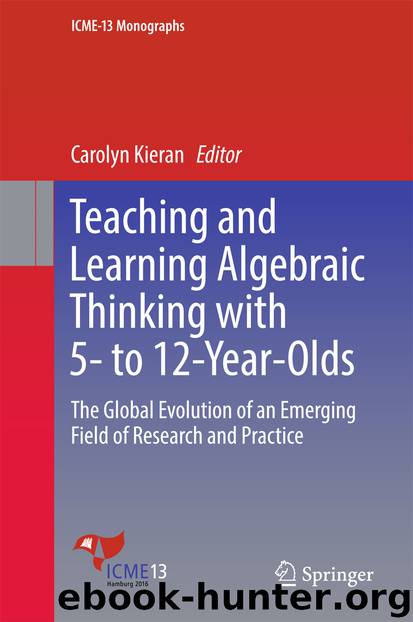Teaching and Learning Algebraic Thinking with 5- to 12-Year-Olds by Carolyn Kieran

Author:Carolyn Kieran
Language: eng
Format: epub
Publisher: Springer International Publishing, Cham
9.2.3 Observations of Structure
Strømskag (2015) defines a shape pattern as a sequence of terms, composed of ‘constituent parts,’ where some or all elements of such parts may be increasing, or decreasing, in quantity in systematic ways. While a limited number of terms of a shape pattern may be presented for consideration, the pattern is perceivable as extending until infinity. In order to construct a general term for a shape pattern, children must “grasp a regularity” in the structure of the terms presented, and generalize this regularity to terms beyond their perceptual field (Radford 2010, p. 6). Similarly, Mulligan and Mitchelmore (2009) present “structure” as the definition of a pattern, which is most often expressed as a generalization , being a “numerical, spatial, or logical relationship, which is always true in a certain domain” (p. 34).
In seeking to construct a generalization for a pattern , children may adopt a variety of approaches. Lannin et al. (2006) identified an explicit approach as establishing a relationship between a term and its position in the pattern. In contrast, a recursive approach involves comparing consecutive terms in order to identify a relationship, which is then used to construct subsequent or preceding terms. A ‘whole-object’ strategy entails identifying a term of the sequence as a unit, and constructing other terms by generating multiples of the unit. To gain insight into a greater range of patterning, and a structural understanding beyond the most basic repeating patterns, children may benefit from opportunities to consider an explicit approach, and some children may require intervention to do so (Lannin et al. 2006; Rivera and Becker 2011). Thus, teaching activities and materials should avoid overusing sequences that foster a recursive approach. Students need recourse to both explicit and recursive methods of solving patterns, and their thinking should be developed to include an ability to determine which method is appropriate in a particular situation (Lannin 2004). Watson et al. (2013) concur by emphasizing that explicit and recursive thinking should not be considered as hierarchical but complementary, and that children will be supported in developing robust, flexible reasoning skills when facilitated in engaging with both.
Download
This site does not store any files on its server. We only index and link to content provided by other sites. Please contact the content providers to delete copyright contents if any and email us, we'll remove relevant links or contents immediately.
The Art of Coaching Workbook by Elena Aguilar(50739)
Trainspotting by Irvine Welsh(21420)
Twilight of the Idols With the Antichrist and Ecce Homo by Friedrich Nietzsche(18443)
Fangirl by Rainbow Rowell(9009)
Periodization Training for Sports by Tudor Bompa(8091)
Change Your Questions, Change Your Life by Marilee Adams(7552)
This Is How You Lose Her by Junot Diaz(6694)
Asking the Right Questions: A Guide to Critical Thinking by M. Neil Browne & Stuart M. Keeley(5569)
Grit by Angela Duckworth(5442)
Red Sparrow by Jason Matthews(5317)
Paper Towns by Green John(5018)
Room 212 by Kate Stewart(4956)
Ken Follett - World without end by Ken Follett(4588)
Housekeeping by Marilynne Robinson(4246)
The Sports Rules Book by Human Kinetics(4207)
Papillon (English) by Henri Charrière(4138)
Double Down (Diary of a Wimpy Kid Book 11) by Jeff Kinney(4130)
The Motorcycle Diaries by Ernesto Che Guevara(3925)
Exercise Technique Manual for Resistance Training by National Strength & Conditioning Association(3900)
